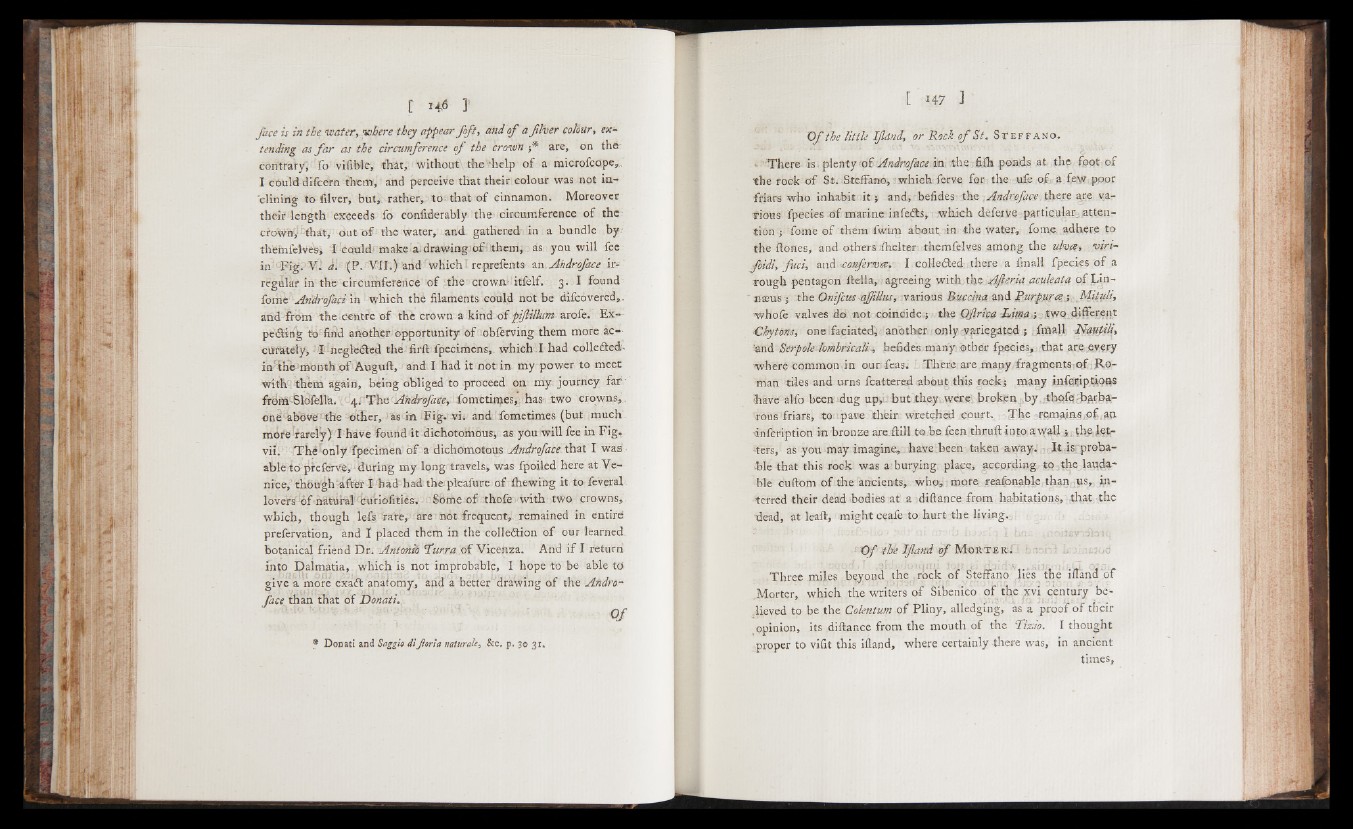
face is in the. water, inhere they appear fo ft, and o f afPoer colour, extending
as fa r as the circumference o f the crown are, on thd-
con trary; fo vifible, that, without the''help o f a microfcope,.
I cùuld diicern them; and perceive that their colour was not inclining
to filver, but,, rather, to that o f cinnamon. Moreover
their length exceeds fo eonfiderably the .circumference o f the:
crown,- -that, out o f the water, and gathered'in a bundle by
themfelves, I could1 make a. drawing of'ithem; as you will fee
in '•’Fig. V . a. (P. V II.) and which ireprefentsan. Androface ir?
regular in the circumference o f the crown- itfelf. 3. I found
fome Androfaci in which the filaments could not be difcovered,.
and from the, Centre o f the crown a kind o f pjftilkm arofe. Expecting
to find another opportunity o f obferving them more accurately,
I hegleéted the firft fpecimens,, which .1 had collected-
in the month o f Auguft, and. I had it not in my power to meet
with them again, being obliged to proceed on my. journey far
from Slofella. 4. The AhdrqJ'ace, lometiraes, has- two crowns,
onècabòve the other, as in Fig. vi. and: fome times (but much
more rarely) I have found it dichotoihous, as you will fee in Fig,
vii. T h è 'only fpecimen o f a dichOmotous Androface¡ that I was
able to pieferve, during my long travels, was fpoiled here at Venice,’
though after I had had the pleafure of ihewing it to feveral
lovers-bfmàtuial curiofitiés. Some o f thofe with two crowns,
which, though lefs rare, are not frequent, remained in entire
prefervation, and 1 placed them in the collection o f our learned
botanical friénd Dr. Antonio Purr a o f Vicenza. And i f I return
into Dalmqtia, which is not improbable, I hope to be able td
give a more exaCt anàfomy, and a better drawing o f the Androface
than that o f Donati.,
• » • t o M ^ W W fc ", - O f
* Dopati and Saggi» diJioria naturale, &c. p. 30 31.
O f the little IJldnd, or Rock o f S t. S t e f f a n o .
- There is. plenty<oi Androface.in. the,fifis ponds at the foot of
the rock o f St. Steffano, which ferve for the ufe o f , a few ppor
friars who inhabit i t , and., befides the .Androface there are various
fpecies o f marine infeâs, which deferve particular^,attention
; fome of themfwim about >in the water, fome adhere to
the ftones, and others fhelter, themfelves among the u h o , viri-
foidi, fu ci, and confervne.' I colleCled:, there a final! fpecies o f a
rough pentagon ftella, agreeing with.thp .Afteria. aculeata o f Lin-
næus j the Onifcus aJjiUus, various Bvccina and P-urpp.ro: ; Miltth,
whole valves do not coincide,; the Ofiri'çg. Lima ; two different
•Chytonsi one faciated,1 another only ryariegated ; fmall Naupili,
tand Serpole lombricali, hefides.many other fpecies, that are every
where common,in ounfeas. There are many fragments ¡of ^Roman
tiles and urns fcattered about this rock; many jpPggiptipflS
bave alfo been dug u p .ib u t they were broken ..by thofe barbarous
friars, to pave their wretched court. The remains^of ap.
infcription in bronze areftill to be feenthruftintoav^all ^he,¿efj-
»ters, as you may imagine, have been taken away.'- Itisrproba-
-ble that this rock was a burying place, according to the laudable
cuftom o f the ancients, who, more reafonabie than ,usa interred
their dead bodies at a dill ance from habitations, that the
-dead, at leaft, might eeafe to hurt the living,.
! O f the IJland o f M o r t e kT. bnsnl
Three miles beyond the .rock o f Steffano liés "the iffand'of
.Morter, which the writers of Sibehico o f t h e x v i century believed
to be the Colentum o f Pliny, alledging, as â proof o f their
opinion, its diftance from the mouth o f the fiz io . I thought
proper to vifit this illand, where certainly there was, in ancient
tim e s.